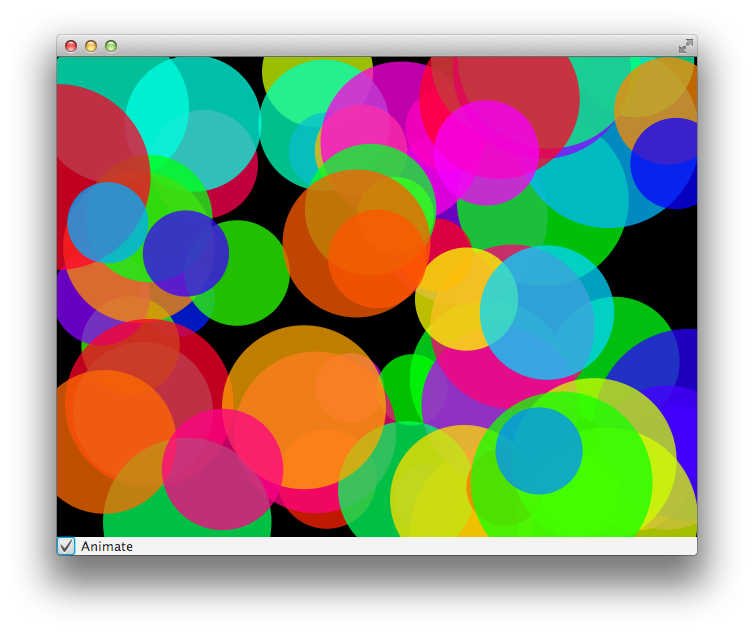In the example below, the static nested class CanvasPane wraps an instance of Canvas in a Pane and overrides layoutChildren() to make the canvas dimensions match the enclosing Pane. Note that Canvas returns false from isResizable(), so "the parent cannot resize it during layout," and Pane "does not perform layout beyond resizing resizable children to their preferred sizes." The width and height used to construct the canvas become its initial size. A similar approach is used in the Ensemble particle simulation, FireworksApp, to scale a background image while retaining its aspect ratio.
As an aside, note the difference from using fully saturated colors compared to the original. These related examples illustrate placing controls atop the animated background.
![image]()
import java.util.LinkedList;
import java.util.Queue;
import java.util.Random;
import javafx.animation.AnimationTimer;
import javafx.application.Application;
import javafx.beans.Observable;
import javafx.scene.Scene;
import javafx.scene.canvas.Canvas;
import javafx.scene.canvas.GraphicsContext;
import javafx.scene.control.CheckBox;
import javafx.scene.layout.BorderPane;
import javafx.scene.layout.Pane;
import javafx.scene.paint.Color;
import javafx.stage.Stage;
/**
* @see https://mcmap.net/q/677718/-automatically-resize-canvas-to-fill-the-enclosing-parent
* @see https://mcmap.net/q/146408/-passing-current-date
*/
public class Baubles extends Application {
private static final int MAX = 64;
private static final double WIDTH = 640;
private static final double HEIGHT = 480;
private static final Random RND = new Random();
private final Queue<Bauble> queue = new LinkedList<>();
private Canvas canvas;
@Override
public void start(Stage stage) {
CanvasPane canvasPane = new CanvasPane(WIDTH, HEIGHT);
canvas = canvasPane.getCanvas();
BorderPane root = new BorderPane(canvasPane);
CheckBox cb = new CheckBox("Animate");
cb.setSelected(true);
root.setBottom(cb);
Scene scene = new Scene(root);
stage.setScene(scene);
stage.show();
for (int i = 0; i < MAX; i++) {
queue.add(randomBauble());
}
AnimationTimer loop = new AnimationTimer() {
@Override
public void handle(long now) {
GraphicsContext g = canvas.getGraphicsContext2D();
g.setFill(Color.BLACK);
g.fillRect(0, 0, canvas.getWidth(), canvas.getHeight());
for (Bauble b : queue) {
g.setFill(b.c);
g.fillOval(b.x, b.y, b.d, b.d);
}
queue.add(randomBauble());
queue.remove();
}
};
loop.start();
cb.selectedProperty().addListener((Observable o) -> {
if (cb.isSelected()) {
loop.start();
} else {
loop.stop();
}
});
}
private static class Bauble {
private final double x, y, d;
private final Color c;
public Bauble(double x, double y, double r, Color c) {
this.x = x - r;
this.y = y - r;
this.d = 2 * r;
this.c = c;
}
}
private Bauble randomBauble() {
double x = RND.nextDouble() * canvas.getWidth();
double y = RND.nextDouble() * canvas.getHeight();
double r = RND.nextDouble() * MAX + MAX / 2;
Color c = Color.hsb(RND.nextDouble() * 360, 1, 1, 0.75);
return new Bauble(x, y, r, c);
}
private static class CanvasPane extends Pane {
private final Canvas canvas;
public CanvasPane(double width, double height) {
canvas = new Canvas(width, height);
getChildren().add(canvas);
}
public Canvas getCanvas() {
return canvas;
}
@Override
protected void layoutChildren() {
super.layoutChildren();
final double x = snappedLeftInset();
final double y = snappedTopInset();
// Java 9 - snapSize is deprecated, use snapSizeX() and snapSizeY() accordingly
final double w = snapSize(getWidth()) - x - snappedRightInset();
final double h = snapSize(getHeight()) - y - snappedBottomInset();
canvas.setLayoutX(x);
canvas.setLayoutY(y);
canvas.setWidth(w);
canvas.setHeight(h);
}
}
public static void main(String[] args) {
launch(args);
}
}


